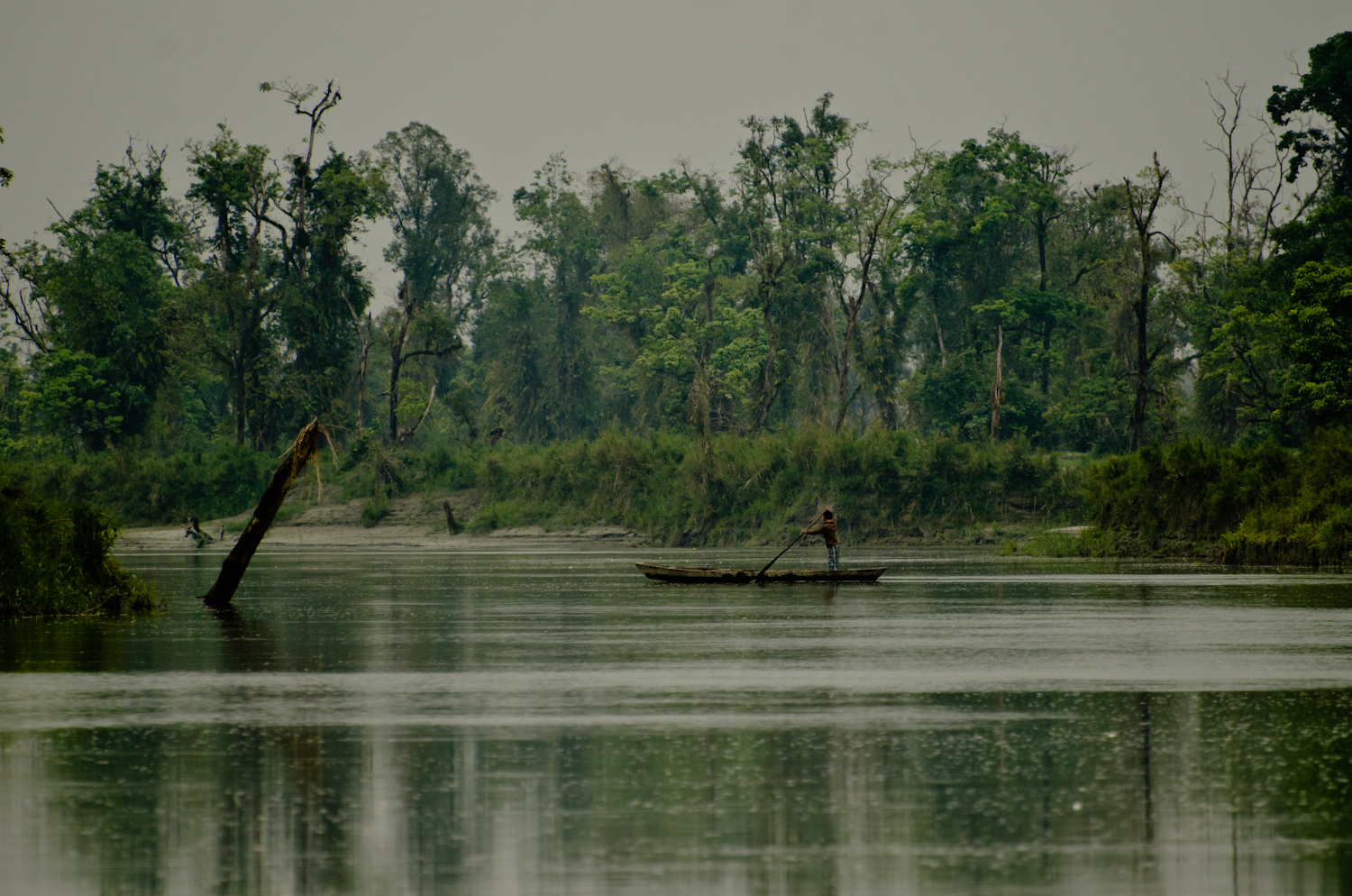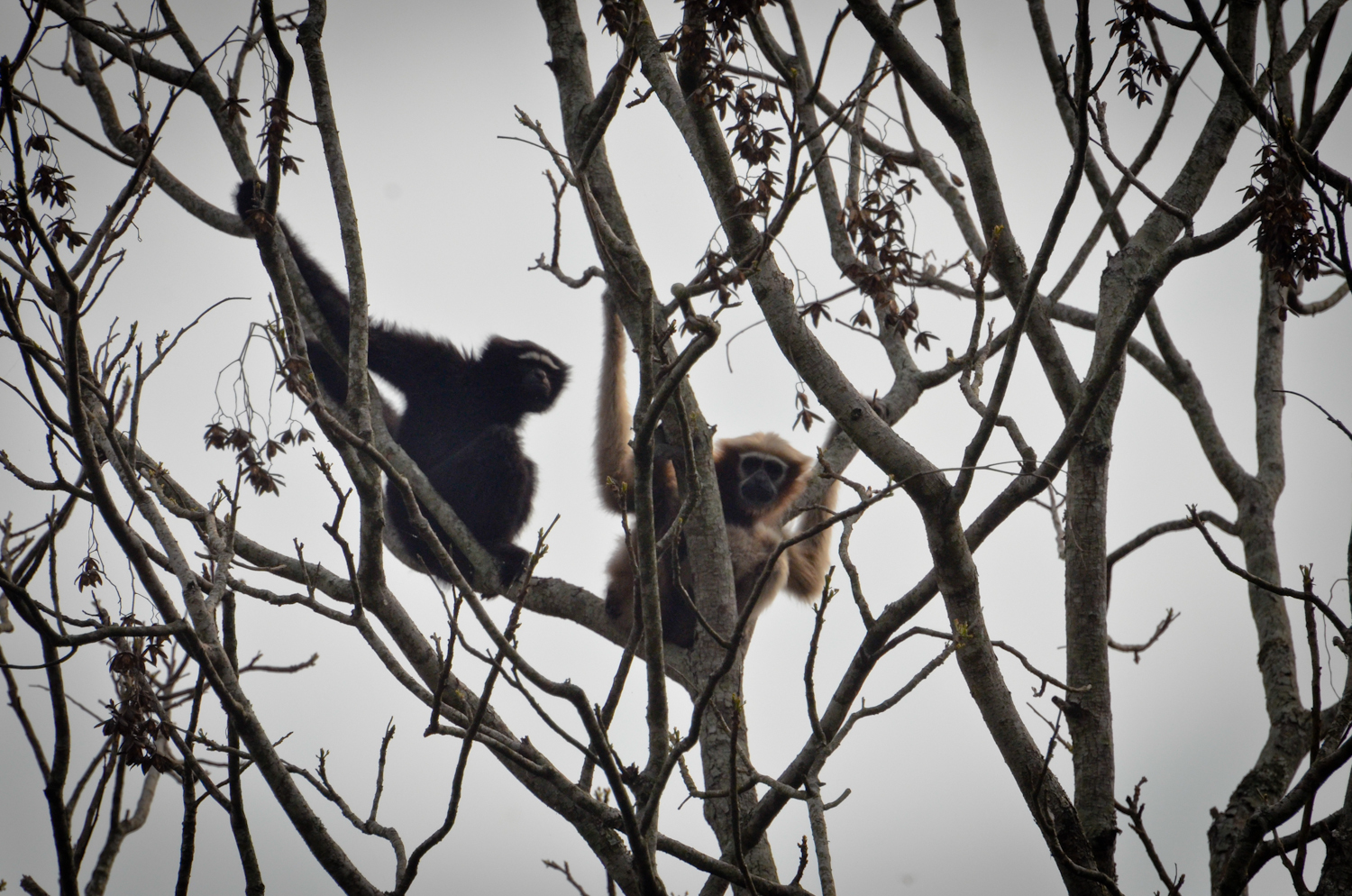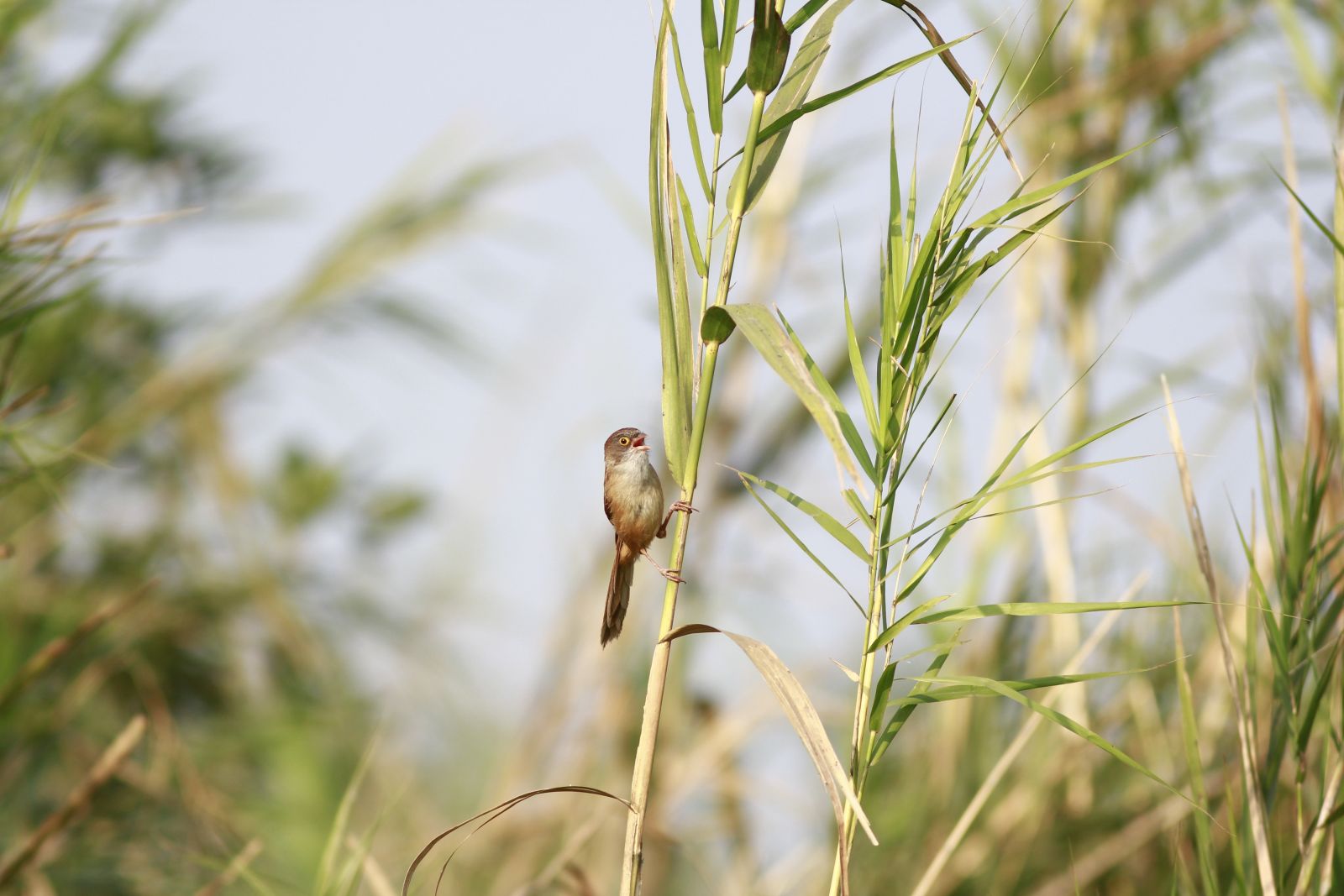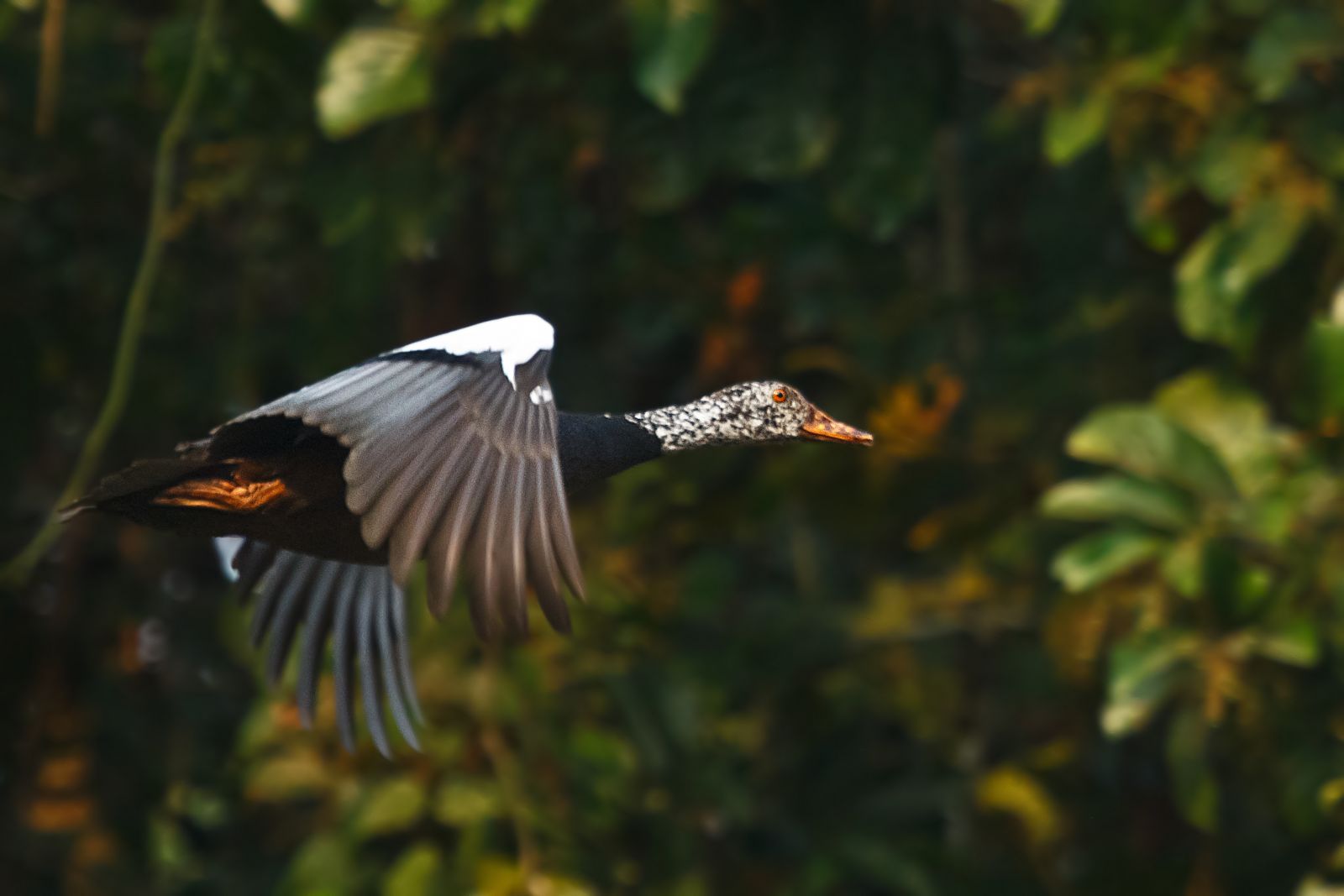Troubled Dibru-Saikhowa
First published in Sanctuary Asia,
Vol. 33
No. 6,
June 2013
By Shailendra Yashwant
Three of India's eastern-most rivers, Siang, Dibang and Lohit, meet the mighty Brahmaputra river at a unique tri-junction near the borders of upper Assam and Arunachal Pradesh. Located at this confluence, on an island about 12 km. from the tea town of Tinsukia, is the Dibru-Saikhowa National Park and Biosphere Reserve. Spread over 765 sq. km., of which 340 sq. km. form the core of this magical land, this park is a complex of wetlands, grasslands, littoral swamps and semi-evergreen forests, including the largest salix swamp forest in Northeast India.
Walking from Kundaghat to the Balijan forest check post inside the Dibru-Saikhowa National Park on a wet day in April 2013, I spotted Citrine Wagtail, Sultan Tit, Common Stonechat, Indian Roller, Yellow-bellied Prinia, a silhouette of a hornbill that swooped overhead and finally a Jerdons Bushchat, a black and white sparrow-sized bird that had not been seen in these parts for over two years. Winter, when the many rivulets and rivers crisscrossing the park have dried up, is the only time when the trek is possible. When the rains pour down, and even for several months after that, access is by boat alone.
In the distance, I heard Hoolock gibbons singing their strange songs high up in the canopy of silk cotton, Indian lilac, and red cedar trees. I also saw macaques scampering along the branches of a shisham tree and followed a wild hare through my field glasses as it made its way across a clearing in the grassland. Toward the edge of the grassland, a herd of elephants had rested the night before and I could see tell-tale evidence of their fruit-feast from the Outenga (elephant-apple) tree. Around me was a virtual wonderland. I saw willow trees… the ones that make such great cricket bats and hockey sticks. Also what locals call kappofool, the gorgeous pink orchid, in full bloom that heralded the Assamese spring festival of Bihu.
On the boat back to the mainland, Gangetic river dolphins surfaced near us as they fed from waters that also supported Spot-billed Ducks, herons and an amazing diversity of other waterfowl. In the distance, on the banks of one of the chaporis, I spotted a herd of wild buffaloes retreating into their forest.
Dibru-Saikhowa in spring teems with life of all descriptions, like a virtual showcase of the incredible biodiversity that Northeast India harbours. In my book, Dibru-Saikhowa is up there with Khongchengdzonga and Kaziranga, but as I soon discovered, there is trouble brewing in paradise.

Dibru-Saikhowa National Park, spread over 765 sq. km., is a complex of wetlands, grasslands, littoral swamps and semi-evergreen forests. Photo: Shailendra Yashwant.
BEAUTY'S BEAST
The life-giving Brahmaputra river is literally consuming Dibru-Saikhowa. Caught in the crosscurrent of the three shifting rivers, this biodiverse haven must simultaneously cope with being gnawed at, deforested, overgrazed, and incessantly burnt by the growing human population and their livestock, which share space with the biodiversity here.
The people of Dadhia and Laika are neither illegal occupants nor encroachers. The villages were created by the Forest Department in the mid-1950s, but because the area was not incorporated in the national park notification, rehabilitation of the residents was not prioritised. Today, the original 50 ha. of the settlement has expanded to roughly 500 ha. The 2,132 families and their 100,000 cattle have little future unless they are assisted in moving off the island. Their leaders confirm that the people are fed up with the floods and the lack of access to the mainland. But finding alternative sites is proving difficult.
Meanwhile, the free access of their cattle to fragile forest areas has wreaked havoc on endangered animals including the tiger, clouded leopard, dhole, sloth bear, Hoolock gibbon and even a small but celebrated herd of feral horses. Virtually no one can predict the future of such rare birds as the Black-breasted Parrotbill, Bengal Florican, White-winged Duck and other rare avians.
Dr. Vaibhav Mathur, Divisional Forest Officer, is as motivated as any wildlifer I have ever met: “You try to figure out how 25 guards can protect a forest when 2,000 families daily impact the forest. Two years ago, two of our forest posts, Miripathar and Kalia, were raided by an armed ultra-left faction that stole four of our guns. I have one speed boat but no money for petrol. Since 1997, we have received only 2.4 crores and most of this went into the construction of this office and interpretation centre. I have just discovered that I have been allotted no budget at all for 2013-2014. So what should I do?"
Joynil Abedin, a well-known poacher turned conservationist, Secretary of the Dibru-Saikhowa Conservation Society, an avid birder and owner of Banashree Eco Camp, ran a strident campaign that led to the transfer of the previous DFO. He blames government officials for the mess: “The Revenue Department, Forest Department, politicians, even the army (during their two-year Operation Bajrang) have systematically devastated this forest. Joynil should know. His father was a forest contractor and in his own younger days Joynil hunted leopards and wild buffaloes at the behest of some army officers. Although reformed, he is hardly repentant: “I didnt know better, game hunting is an ancient practice in these parts, its only in the 80s that we found out that game hunting was banned and illegal and was now known as ‘poaching. I wonder if the army officers knew," he commented sarcastically.
Joynil also blames the lack of coordination among various government and non-government agencies and institutions for the current abysmal state of affairs, which has resulted in the unconscionable decision to allow three new polluting oil pipeline projects by Oil India Ltd. within the impact zone of this wonderland. This is the result of the latest find of oil at Baghjan near Tinsukia and the three proposed pipelines could well be the last straw on the proverbial camels back.
Already seething at the manner in which Delhi passes diktats involving the future survival of a people totally dependent on the health of their forests, rivers and lakes, Bimal Gogoi, a local activist, angrily states: “Locals are not opposed to the transportation of oil and gas, they want the pipelines to be aligned to skirt the ecologically sensitive area. Why the National Board of Wildlife (NBWL) Standing Committee members, who should have known better, acquiesced, without so much as a site visit or consultation with the local people, purely on the project proponents asking, defies logic. We demand a review of this clearance and will fight for it in court."

Photo: Shailendra Yashwant.
WITHER NBWL
The NBWL, once a highly respected institution, has not covered itself in glory where dams are concerned either. The NBWLs poor record dates to the fiasco with the Lower Subansiri Dam, when the PMO and the MoEFCC jointly conspired to ignore sage advice and hammered clearance through by bending the law and abusing their power and position. We must now confront the damage from the three dams on Lohit, Dibang and Siang, whose relatively uniform flows of around 1,920 cumecs (cubic metres per second) at the tri-junction of the rivers at Dibru-Saikhowa in January will fluctuate wildly between 663 and 7,610 cumecs (that's the amount of water that the area sees during the monsoons!) every single day.
It takes no genius to conclude that three to four metre (10-13 feet) high water level fluctuations impacts in the park in winter will destroy the ecosystem. No species can possibly adapt and survive such violence. Floods were always meant to be a seasonal gift that brought fertility to valleys. This insane set of water flows will permanently damage the ecology of the Protected Area whose grasslands and other breeding grounds of critically-endangered birds and mammals will quite simply die. It is pointless to speculate as to whether hibernating reptiles and amphibians have even a ghost of a chance of surviving the flood. And as for downstream livelihoods of communities, their dependence on fish, farms and even simple river transportation and livestock rearing will be a thing of the past.
If another country were to do to the 32 million people of Assam what New Delhi is doing to them, it would be tantamount to a declaration of war.
Neeraj Vagholikar of Kalpavriksh (See Sanctuary Vol. XXXI No. 2, April 2011), who has been studying the impacts of big dams in the Northeast since 2001, said to Sanctuary: “Post-clearance studies were earlier commissioned for the 2,000 MW Lower Subansiri and 1,500 MW Tipaimukh Projects in the region. After pressure from civil society groups, the Terms of Reference for the post-clearance downstream study prescribed by the MoEFCCs Expert Appraisal Committee (EAC) for the Demwe Lower Project did ask for a study of impact on Important Bird Areas, but the MoEFCC simultaneously took a curious position in an affidavit filed before the National Environmental Appellate Authority (NEAA) justifying the clearance quixotically by artlessly claiming that ‘lower-down-the-river projects are in a less ecologically fragile zone."
Driving back from Magori Bheel, I stopped at Baghjan village, where three discreet oil pumps marked the spot where the controversial oil pipelines will be laid from under the Magori Bheel towards Dulaijan. Dipolab Chutia, a local activist, told me about the 23 Hoolock gibbons that have forsaken the small patch of Borjan-Bherjan-Padumoni Wildlife Sanctuary in the vicinity to stay on in the Baghjan village for the last six years. He made a few phone calls to locate them and a cousin confirmed their presence a few houses away.
I gazed in wonder and sadness at them. I could see a couple, a brown female and a black male, with a beige-coloured little one high up on a Ficus tree, feeding at leisure. Not one EIA study for the pipeline or for the dams makes mention of these primates, facetiously offered the highest degree of protection under Schedule One of the Wildlife (Protection) Act, 1972. I took a few photographs and began driving back when the bizarre took a turn for the surreal. I noticed a recently cleared plot sporting a spanking new signboard proclaiming ‘Assam Plastic Park. When I stopped and asked people in the village, they had no clue at all about the ‘plastic park that was about to destroy a national park.

Jerdon's Babbler is a passerine bird native to wetlands and grasslands of the Indian sub-continent. It is listed as Vulnerable on the IUCN Red List. Photo: Md. Imran.
HOPE FLOATS
Everyone I interviewed about Dibru-Saikhowa opined that the habitat had the capacity to recover almost magically, provided the ecological abuse was stopped. In fact, it would rival Kaziranga, most said. Vaibhav Mathur believes that a recent Supreme Court ruling enables Assam to offer degraded forest land to rehabilitate the villages that are impacting and are impacted by Dibru-Saikhowa. Villagers who have visited these sites are poised to accept them as better than their existing areas. Will the Standing Committee of the NBWL take cognisance of Bimal's missive? Who knows? We have an election looming large and that generally means that politicians will use forest lands as coinage for votes. Insider information from the Assam Industrial Development Corporation reveals that bids for the Assam Plastic Park have been less than promising. With luck, the Plastic Park project will collapse before it starts.
At the time of writing, the fiercely independent people of the Northeast seem poised to unite against the large dams that were initially sold to them as the harbingers of hope and development. Today, they know these are little more than modern-day tools of colonisation that will steal their forests and gift them with permanent poverty and dependence on government dole.
And what of Dibru-Saikhowa? Sanctuary Asia has been demanding a moratorium on large dams in the Northeast on just one simple premise… the glaciers on which the water flows were calculated are melting faster than the dam projects can possibly be completed. This makes their cost-benefit ratios a joke. Pushing the dams amounts to a fraud on the people of India, not just on Assam.
With scams of gargantuan proportions doing the rounds across India, I am hoping that the long-suffering populace of India will wake to the truth that their own leaders, like those who pulled the Trojan Horse into Troy to destroy it from within, are selling them down the Brahmaputra. If and when that happy day arrives, perhaps Dibru-Saikhowa might finally be safe.

Photo: Vishwatej Pawar.




